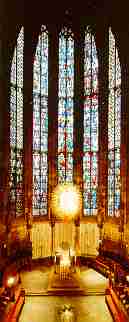UNESCO World Heritage in Germany

Aachen Cathedral
The manifestation of a »New Rome«
- this was Charlemagne's guiding vision when he
began the construction of the Palace Chapel in the
former Roman spa resort Aachen in 786 - laying the foundation stone
for one of Europe's most outstanding edifices.
 The
cathedral obtained its present shape in the course
of more than a millenium. The core of the Aachen cathedral is the
formerly mentioned Palace Capel - at the time of its construction it
was the largest dome north of the Alps. Its fascinating
architecture with Classical, Byzantine and
Germanic-Franconian elements is the essence of a monumental building
of greatest importance: for 600 years, from 936 to 1531, Aachen
cathedral was the church of coronation for 30 German
kings. In order to bear the enormous flow of pilgrims in the Gothic
period a choir hall was built: a two-part Capella vitrea
(glass capel) which was consecrated on the 600th day of Charlemagne's
death.
The
cathedral obtained its present shape in the course
of more than a millenium. The core of the Aachen cathedral is the
formerly mentioned Palace Capel - at the time of its construction it
was the largest dome north of the Alps. Its fascinating
architecture with Classical, Byzantine and
Germanic-Franconian elements is the essence of a monumental building
of greatest importance: for 600 years, from 936 to 1531, Aachen
cathedral was the church of coronation for 30 German
kings. In order to bear the enormous flow of pilgrims in the Gothic
period a choir hall was built: a two-part Capella vitrea
(glass capel) which was consecrated on the 600th day of Charlemagne's
death.
Eversince, the magnificent architecture of the
»glass house« of Aachen has never stopped to be admired:
Aachen cathedral has lost nothing of its splendour in the course of
history. Its inclusion in the list of the German UNESCO World Heritage
as the first German »architectural and artistic
historical ensemble« is an unequivocal evidence of its
importance.
The Aachen cathedral treasury
displays sacral masterpieces of the late Classical,
Carolingian, Ottonian and Staufian period - among them there are som
unique exhibits like the »Cross of Lothair«
the »Bust of Charlemagne« and the
»Persephone sarcophagus«. The Cathedral
Treasury in Aachen is regarded as one of the most important
ecclesiastical treasuries in northern Europe.
Links to World Heritage in Germany - UNESCO's World Heritage List - to HomePage
Deutsche Version
22 May 1998 - If you have any comments or questions, please contact me: Wolfgang M. Werner wmwerner@compuserve.com


 http://www.bawue.de/~wmwerner/english/heritage/aachen.html (Internet on a CD, 07/1998)
http://www.bawue.de/~wmwerner/english/heritage/aachen.html (Internet on a CD, 07/1998)